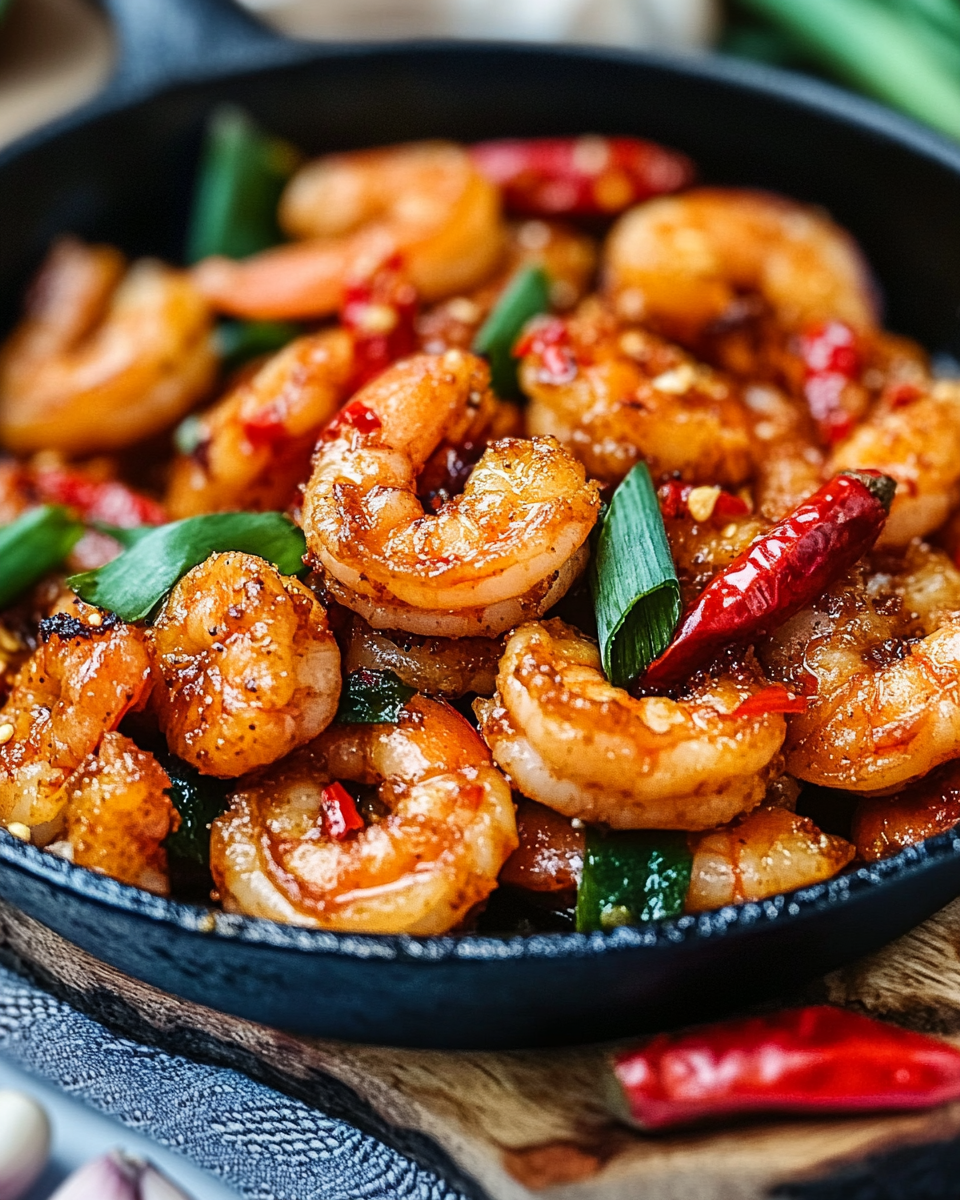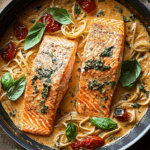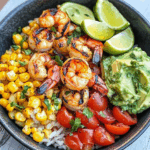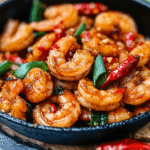A quick and delicious way to enjoy restaurant-style crispy salt and pepper shrimp at home. Perfectly crunchy with a flavorful kick, this dish makes a great appetizer or snack that’s sure to impress.
FULL RECIPE
Ingredients
- 1 lb large shrimp, peeled and deveined
- 1/2 cup cornstarch
- 1 tsp salt
- 1 tsp black pepper
- 1/2 tsp white pepper (optional)
- 1/2 tsp garlic powder
- 1/4 tsp cayenne pepper (optional for heat)
- 3 green onions, finely chopped
- 2 cloves garlic, minced
- 1 small red chili, thinly sliced (optional)
- Vegetable oil, for frying
- Lemon wedges, for serving
Directions
- Pat the shrimp dry with paper towels.
- In a bowl, combine cornstarch, salt, black pepper, white pepper, garlic powder, and cayenne pepper.
- Toss the shrimp in the cornstarch mixture until fully coated. Shake off excess.
- Heat vegetable oil in a deep skillet or wok over medium-high heat (about 350°F/175°C).
- Fry the shrimp in batches for 2-3 minutes until golden and crispy. Remove and drain on paper towels.
- In a separate pan, heat a small amount of oil, add minced garlic, sliced chili, and green onions; sauté for 30 seconds until fragrant.
- Toss the fried shrimp in the garlic and pepper mixture until well coated.
- Serve immediately with lemon wedges on the side.
Nutritional Information
- Calories: 320
- Protein: 30g
- Total Fat: 15g
- Saturated Fat: 2.5g
- Carbohydrates: 15g
- Fiber: 1g
- Sugar: 1g
- Sodium: 750mg
The Origin of Salt and Pepper Shrimp
Salt and pepper shrimp is a classic dish with roots in Cantonese cuisine, widely loved across many Asian cultures. It originated as a simple stir-fried seafood dish that highlights fresh shrimp seasoned with salt, white pepper, and black pepper, sometimes accompanied by garlic and chili for extra flavor. Over time, the crispy fried version became popular in Chinese takeout menus worldwide, admired for its crunchy texture and balanced seasoning. This dish perfectly captures the harmony between simple ingredients and bold seasoning, reflecting traditional cooking techniques that elevate humble seafood into a flavorful delight.
Why Use Cornstarch for Crispiness
Cornstarch is a staple in many Asian frying recipes because of its ability to create a light, crispy coating. Unlike flour, cornstarch absorbs less oil and forms a delicate crust that doesn’t become soggy quickly. When shrimp are coated in cornstarch and deep-fried, the starch gelatinizes and crisps up on the surface, locking in the shrimp’s natural juiciness. This technique is essential for achieving the iconic crunch associated with salt and pepper shrimp, making it a critical step in the recipe.
The Role of Pepper Varieties
The combination of black pepper and white pepper is key to the distinctive flavor profile of salt and pepper shrimp. Black pepper adds a pungent heat and aroma, while white pepper delivers a milder, earthier warmth. Using both allows the dish to have a layered peppery kick without overwhelming the palate. Some versions even include a pinch of cayenne pepper for added spiciness, making the shrimp pleasantly fiery. This blend of peppers enhances the dish’s complexity, making every bite interesting and flavorful.
Garlic and Chili – Flavor Enhancers
Garlic and chili are often included in salt and pepper shrimp to bring an aromatic depth and subtle heat. The minced garlic, sautéed briefly, releases a fragrant base that complements the shrimp’s natural sweetness. Thin slices of fresh chili add sharp, lively heat that balances the saltiness and peppery notes. Together, these ingredients elevate the dish from simple fried shrimp to a vibrant, mouthwatering appetizer, making it impossible to stop eating after just one bite.
Choosing the Right Shrimp
The type and size of shrimp used can greatly influence the outcome of the dish. Large, peeled, and deveined shrimp are preferred for salt and pepper shrimp because they offer the right balance of tenderness and meatiness. Fresh or properly thawed shrimp provide the best texture, avoiding a rubbery or mushy result. Medium to large shrimp also hold up well during frying without shrinking excessively, ensuring a satisfying bite every time.
Deep-Frying Techniques for Perfect Texture
Deep-frying is the method that gives salt and pepper shrimp its signature crispy exterior. Maintaining the oil temperature around 350°F (175°C) is crucial to avoid greasy or undercooked shrimp. Frying in small batches prevents overcrowding, which can lower the oil temperature and result in soggy coating. Proper draining on paper towels removes excess oil, keeping the shrimp light and crunchy. Mastering these frying tips guarantees a golden, crisp shrimp that tastes just like your favorite takeout.
Variations in Salt and Pepper Dishes
Salt and pepper seasoning is incredibly versatile and can be applied to various proteins and vegetables. Beyond shrimp, salt and pepper chicken wings, tofu, squid, or even green beans are popular adaptations. Each variation uses the same basic seasoning principles, delivering a crisp texture and bold, savory flavor. This adaptability has made salt and pepper seasoning a beloved choice for quick, flavorful meals across different cuisines.
Serving Suggestions and Pairings
Salt and pepper shrimp shines as an appetizer but also works well as a main course when paired with steamed rice or noodles. It can be served alongside other Chinese dishes like fried rice, stir-fried vegetables, or dim sum items for a balanced meal. A squeeze of fresh lemon or lime adds a refreshing citrus note that cuts through the richness of the fried shrimp, enhancing the overall taste experience. Light dipping sauces such as sweet chili or soy-based dips can complement the dish without overpowering it.
Nutritional Considerations
While delicious, salt and pepper shrimp is a fried dish and contains a moderate amount of fat and sodium. Using fresh shrimp provides a good source of lean protein, essential vitamins, and minerals like selenium and vitamin B12. To make it a bit healthier, you can control the oil amount and pair it with nutrient-dense sides like steamed vegetables. For those watching their sodium intake, adjusting the salt quantity or opting for low-sodium seasoning alternatives can help maintain the flavor without excess salt.
Tips for Making Salt and Pepper Shrimp at Home
Making this dish at home requires a few simple but important tips to replicate the restaurant-quality results. First, ensure the shrimp are well dried before coating to help the cornstarch adhere better. Second, don’t skip resting the shrimp briefly after coating to let the crust set. Third, maintain a consistent oil temperature to ensure even frying. Finally, toss the shrimp quickly in the aromatic garlic and pepper mixture after frying to keep the coating crisp and the flavors fresh. With practice, you can easily master this addictive dish in your own kitchen.
Common Mistakes to Avoid
A few common mistakes can diminish the quality of salt and pepper shrimp. Overcrowding the pan causes oil temperature to drop and results in soggy shrimp. Using wet shrimp or skipping the drying step prevents proper crispiness. Over-frying shrinks the shrimp and makes them tough, while under-frying leaves them greasy. Adding the garlic and peppers too early can burn the aromatics and create a bitter taste. Being mindful of these pitfalls helps ensure the dish is always perfectly crispy, flavorful, and enjoyable.
The Popularity of Salt and Pepper Shrimp Globally
Salt and pepper shrimp has become a global favorite, especially in Western countries where Chinese takeout is common. Its irresistible combination of crunch, spice, and savory notes makes it a crowd-pleaser at parties, restaurants, and home dinners alike. Many food lovers appreciate the balance of simplicity and bold flavors, which is why this dish appears in many fusion and modern Asian menus. Its growing popularity continues to inspire cooks worldwide to create new versions while honoring its traditional roots.
Conclusion
Crispy salt and pepper shrimp is a timeless dish that perfectly marries simple ingredients with bold, satisfying flavors. Its crunchy texture, aromatic seasonings, and easy preparation make it an ideal appetizer or snack for any occasion. By understanding its origins, techniques, and flavor components, you can appreciate why this dish remains a favorite in both home kitchens and restaurants. Whether enjoyed as part of a larger meal or on its own, salt and pepper shrimp offers a delightful experience that celebrates the joy of homemade takeout.






